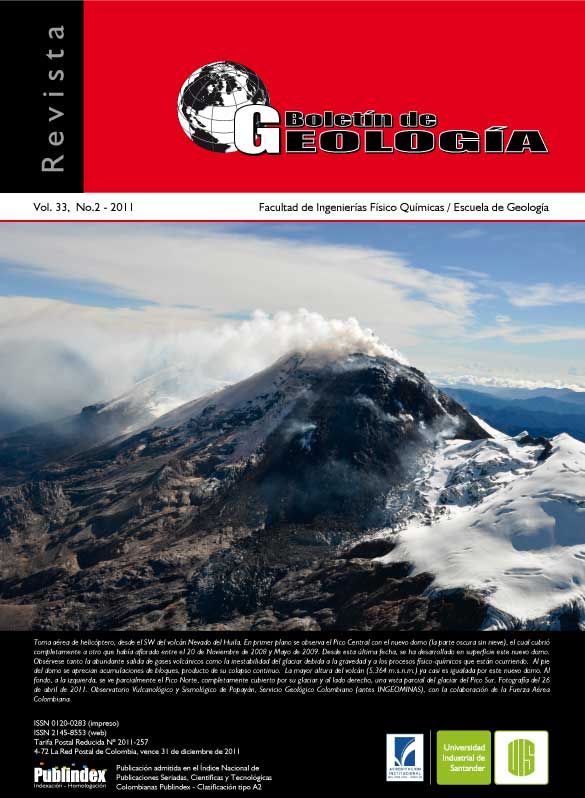PETROLOGY AND GEOCHEMISTRY OF THE INTRUSIVE ROCKS OUTCROPPING BETWEEN MISTRATÓ AND BELÉN DE UMBRÍA TOWNS,(RISARALDA DEPARTEMENT, WEST CORDILLERA COLOMBIANA)
Published 2011-12-06
How to Cite
Abstract
The intrusive rocks studied are located between Mistrató and Belén de Umbría towns, Risaralda department, on the eastern flank of the Western Cordillera, at the west of Cauca-Almaguer Faults System. The north of areais dominant by Microgabbros and Gabbros compound of plagioclase (labradorite), ortopiroxene, clinopiroxene± hornblende. The geochemistry diagrams show low values in potassium, of the tholeitic serie and affinity oceanic. The gabbroic unit has been related with the oceanic terrane of the Western Cordillera. At the south, the outcrops are of acid rocks that go from Quartzdiorite to Granodiorite with higher presence of tonalite. The mineralogy consists of plagioclase (andesine) ± hornblende ± biotite ± alkali feldspar; to the southeast this body is in an intrusive contact with Gabro de Anserma generating a thin contact aureole, and the west presents a wide zone of mylonitic rocks associated with the Mistrató Fault. The Geochemistry results confirm a calco-alkali character, produced in a setting volcanic-arc during the Paleogene.
Keywords: Western Cordillera, Geochemistry, Tholeitic, Calcoalkali, Mistrató Fault.
Downloads
References
Calle, B., y González, H. 1982. Geología y Geoquímica de la Plancha 186 Riosucio. INGEOMINAS, Informe 1878, 124 p. Medellín.Chappel B.W. and White A.Jr. 1974. Two contrasting granite types. Pacific Geology 8: 173-174.
Cox K.G., Bell J.D. and Pankhurst. 1979. The Interpretation of Igneous Rocks. Allen & Unwin, London
González, H. 2002. Catálogo de las unidades litoestratigráficas de Colombia, Cuarzodiorita de Mistrató, INGEOMINAS, Bogotá
González, H. y Londoño, G.A.C. 1998. Edades K-Ar en algunos plutones del Graben del Cauca y norte de la Cordillera Occidental. Universidad Nacional de Colombia, Geología Colombiana, 23: 117-131
Gromet, L. and Silver. L. 1987. REE variations across the peninsular ranges batholiths: implications for batholithic petrogenesis and crustal growth in magmatic arcs. Journal of Petrology, 23(1):75-125
Irvine T.M. and Baragar W.R. 1971. A guide to the chemical classification of common volcanic rocks. Canad J Earth Sci 8: 523-548.
Le-Maitre, R.W. 2002. Igneous Rocks. A Classification and Glossary of Terms. Recommendations of the International Union of Geological Sciences Subcommission on the Systematics of Igneous Rocks, 2nd ed
Maya, M. 1992. Catálogo de dataciones isotópicas en Colombia: Boletín Geológico INGEOMINAS, 32: 127- 187.
Miyashiro, A. 1974. Volcanic rocks series in island arcs and active continental margins. American. Journal of Science. 274:321–355
Moreno, M., Gómez, A. y Toro, L. M. 2008. Proveniencia del material clástico del Complejo Quebradagrande y su relación con los complejos estructurales adyacentes. Boletín de Ciencias de la Tierra, 22: 27-47
Moreno, M., Gómez, A. y Toro, L. M. 2008. Proveniencia del material clástico del Complejo Quebradagrande y su relación con los complejos estructurales adyacentes. Boletín de Ciencias de la Tierra, 22: 27-47
Nivia, Á. 2001. Mapa geológico del Departamento del Valle del Cauca. Escala 1:250.000. Mapa y memoria explicativa. INGEOMINAS, Bogotá, 148p
Pearce, J.A. 2008. Geochemical fingerprinting of oceanic basalts with applications to ophiolite classification and the search for Archean oceanic crust. Lithos 100:14–48
